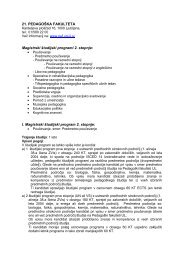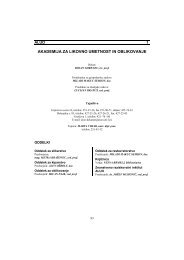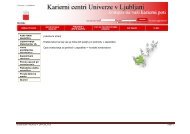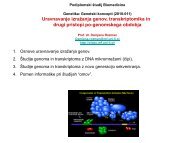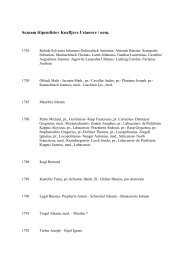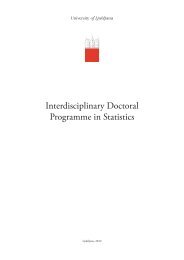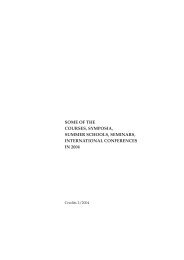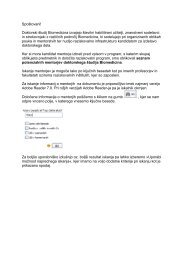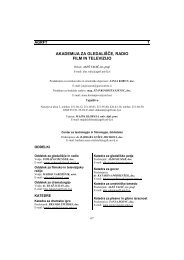Medicinska fakulteta Univerze v Ljubljani 1919–1945 - Univerza v ...
Medicinska fakulteta Univerze v Ljubljani 1919–1945 - Univerza v ...
Medicinska fakulteta Univerze v Ljubljani 1919–1945 - Univerza v ...
Create successful ePaper yourself
Turn your PDF publications into a flip-book with our unique Google optimized e-Paper software.
defined in detail� The rules also determined the duration and<br />
content of individual study courses of the faculties� The study of<br />
medicine thus took five years with the following syllabus:<br />
the 1 st year: Rhetoric, Metaphysics, Physics<br />
the 2 nd year: Natural History and Botany, General Chemistry<br />
the 3 rd year: Anatomy, Physiology, Pharmaceutical Chemistry<br />
the 4 th year: Pathology Clinic, Pharmacology<br />
the 5 th year: Clinic, Modern Medicine, Surgery and Obstetrics<br />
It needs to be said, however, that in practice the study of medicine<br />
differed from the rules� Foreign students, who came to Ljubljana<br />
as graduates of medicine from foreign educational institutions to<br />
do their doctorate here, did not have that choice�<br />
The five-year surgical study was the same as the study of medicine<br />
for the first three years and in the fourth year, the surgeons<br />
studied Anatomy, Pharmacology, Surgery and Obstetrics and in<br />
the fifth year Anatomy and Forensic Medicine� For the first two<br />
years, pharmacists studied together with medical students and in<br />
their third year Natural History and Botany and in the fourth<br />
Botany, Pharmacology and Pharmaceutical Chemistry� The same<br />
as at other faculties, teachers of first-year medical students were:<br />
Agapito Jerome from Buzet for Rhetoric according to his own<br />
notes in Latin, Matevž Ravnikar for Logics and Metaphysics<br />
according to his own notes in Latin and Janez Krstnik Kersnik<br />
for Physics according to the textbook by Franz Ernst Neumann<br />
(Introduction into Theoretical Physics) in Latin� Teachers<br />
in the second year were Franc de Paula Hladnik for Natural<br />
History (Anthropology) and Botany in German, Anton Melzer<br />
for Anatomy in Latin and Jean Marie Zendrini from Brescia in<br />
Italy for General Chemistry in French� Two more teachers were<br />
appointed during the first year of the Faculty of Medicine: Fran<br />
Melzer for Surgery and Obstetrics and Wilibald Schmid for<br />
Pathology and Clinic who, however, were not yet teaching, as it<br />
was believed that these courses should be taught in the last two<br />
years�<br />
In the first academic year of 1810-1811, the Faculty of Medicine<br />
of central schools had 21 students: 7 in the first and 14 in the<br />
second year� Only three students were enrolled in the study of<br />
surgery, one in the first and two in the second year� The latter<br />
attended lectures together with medical students�<br />
At the time of the academy, in the academic years of 1811-1812<br />
and 1812-1813, the Faculty of Medicine underwent an important<br />
change� In both academic years, the study of surgery was added to<br />
the Faculty of Medicine, as there were not sufficient students of<br />
surgery and the Faculty of Surgery was thus formally dissolved� It<br />
needs to be mentioned that Governor General Bertrand issued<br />
a decision that allowed the Faculty of Medicine of the Academy<br />
to also accept “students”, who did not have the required school<br />
education� At the time, France distinguished between two types<br />
of medical personnel: doctors with a faculty education and<br />
117<br />
special health officers (officiers de santé), who were able to take a<br />
practical examination after practicing medicine at a doctor’s office<br />
for six years or at a hospital for five years� In Ljubljana, the Faculty<br />
of Medicine of the Academy was thus supposed to educate not<br />
only doctors but also health assistants and thus also assume the<br />
role of the former Austrian lyceal study of medicine and surgery�<br />
These surgeon apprentices or primary school graduates, who<br />
were being educated for health officers, attended some of the<br />
lectures together with “real” medical students, who were studying<br />
to become doctors� Vlado Schmidt believes that they probably<br />
lowered the level of study work� In any case, such a study system<br />
affected the learning language, as it is improbable that students<br />
learning to become health officers spoke Latin or French�<br />
In the 1811-1812 academic year, when medicine had 24 students<br />
in the first and second year (15 and 9 respectively), at least five<br />
of the first-year students were unskilled and in the next academic<br />
year, three of these students advanced to the second year of<br />
medical study by taking an exam in Anatomy� At that time, the<br />
first-year professors were the same as in the previous academic<br />
year and in the second year, the following professors taught them<br />
in Latin: Anton Melzer Physiology, from May Anton Jeunikar<br />
– instead of the originally appointed Wilibald Schmid, who<br />
emigrated, – Pathology and Pharmacology, Fran Melzer Surgery<br />
and Obstetrics and Janez Krstnik Kersnik General Chemistry (in<br />
French), because Zendrini left Ljubljana�<br />
In the next and last academic year (1812-1813), the Faculty of<br />
Medicine already had three years with 31 students� The only<br />
change in the first year was that Kersnik taught Chemistry in<br />
German� From the seven unskilled students of that year, only<br />
two completed their study obligations� In the second year, the<br />
Melzer brothers (Fran only until March when he died and he was<br />
replaced by his brother Rajmund) taught Physiology, Surgery and<br />
Obstetrics� In the third year, medical students attended lectures<br />
and took exams from Pathology, Special Therapy and Forensic<br />
Medicine that were taught by Anton Jeunikar�<br />
The French higher education school in Ljubljana did not hold<br />
lectures in veterinary medicine and for midwifes� It is known that<br />
Marmont told Zelli that the professor of Surgery and Obstetrics<br />
at the central school should test obstetrics knowledge of female<br />
candidates who had already completed their schooling under<br />
Austrian regime and that the Chancellor should issue them a<br />
diploma� These instructions were observed by central schools�<br />
It was in this form that the French Faculty of Medicine ended its<br />
work in Ljubljana� Only one more year was needed for the first<br />
doctors to graduate in Ljubljana�



